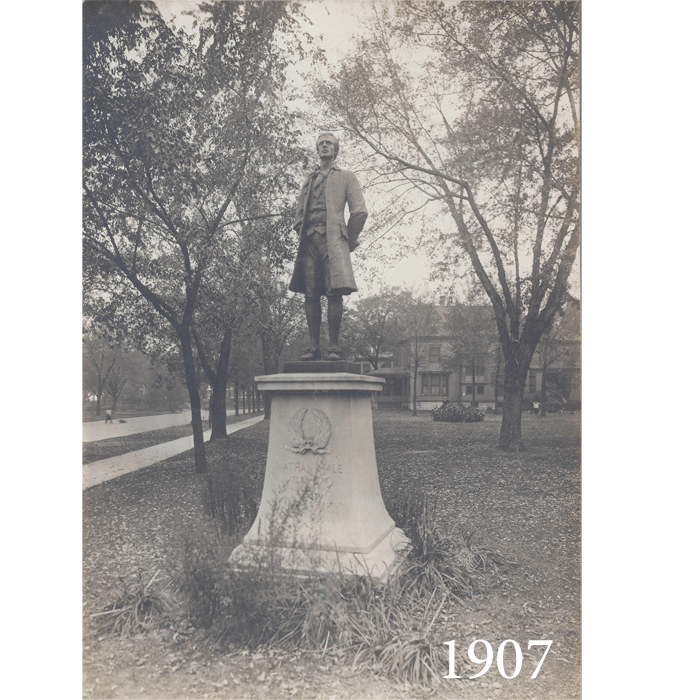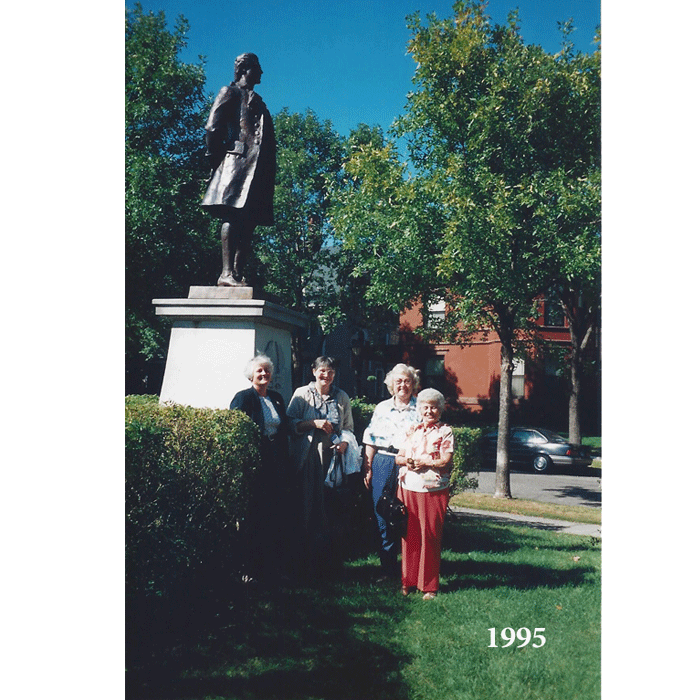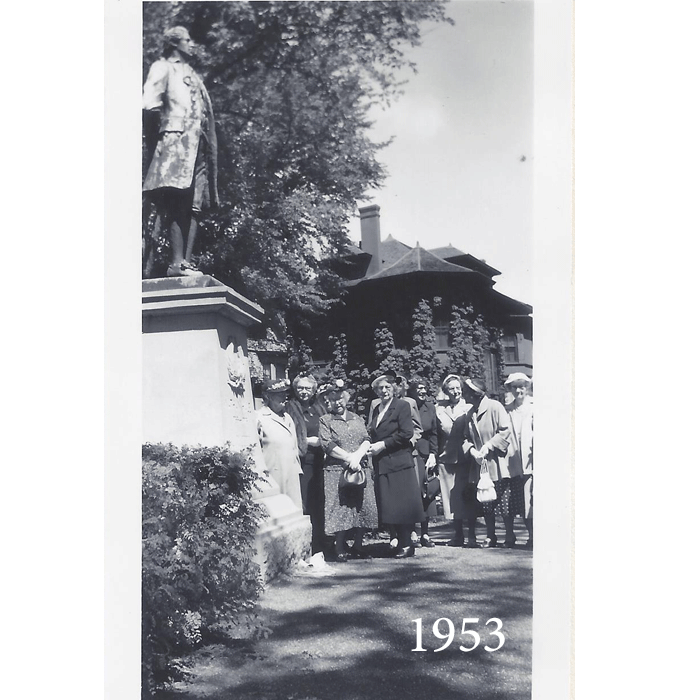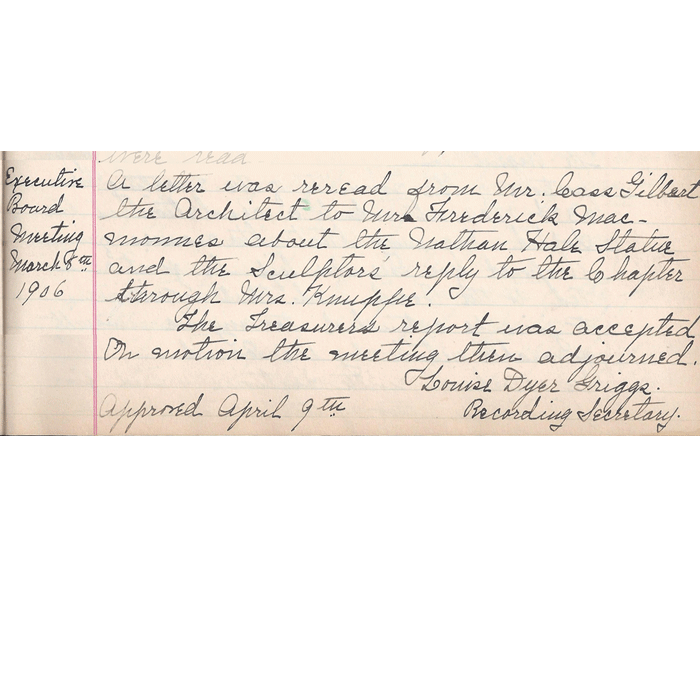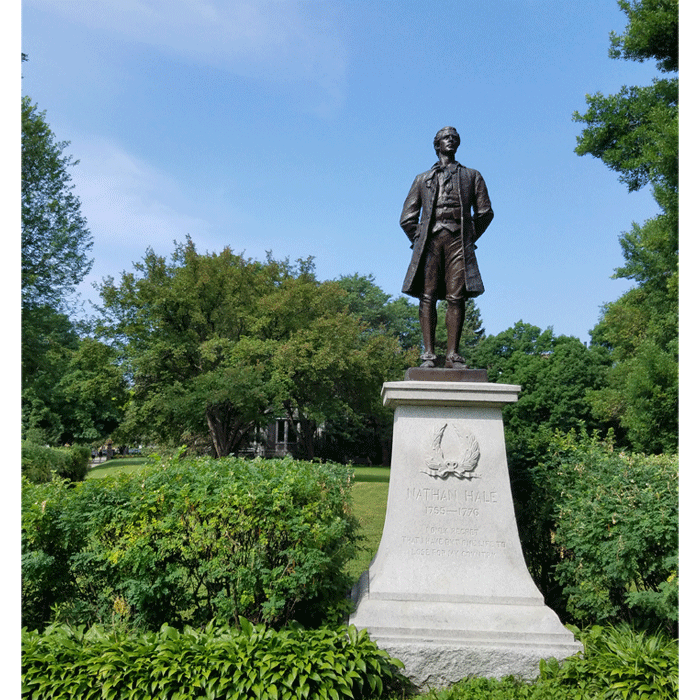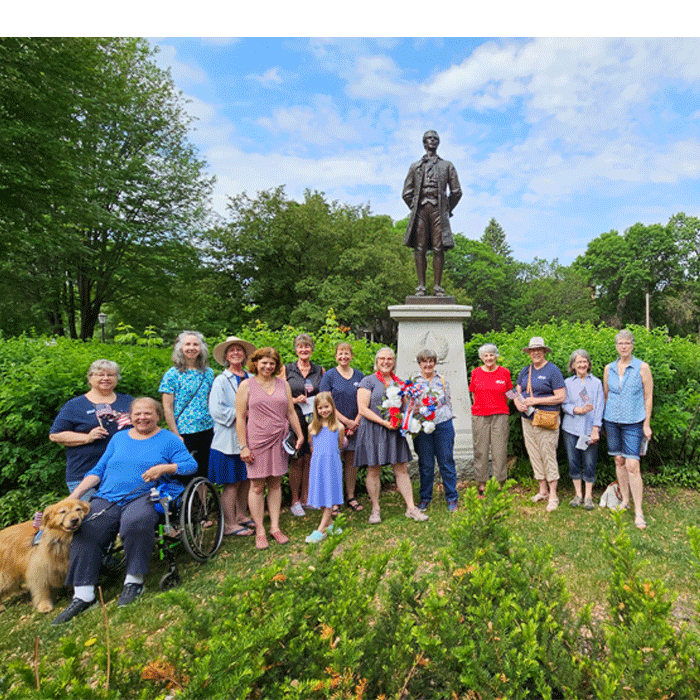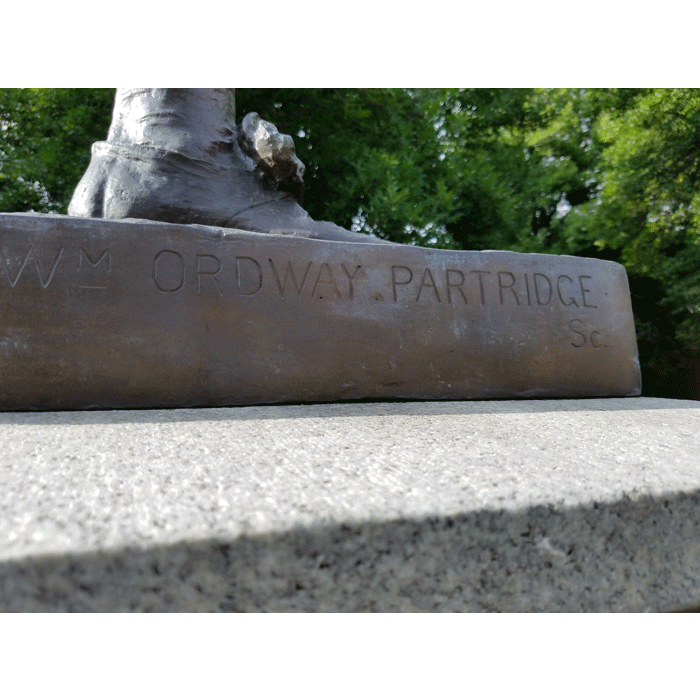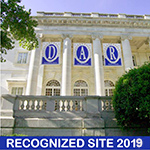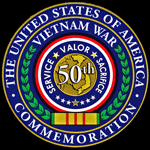Given to the city on July 10, 1907, the Nathan Hale statue was the first monument west of Ohio to honor the patriot. Today, the triangular bit of land is known as Nathan Hale Park at the corner of Saint Paul’s Summit, Portland and Western Avenues. The larger-than-life-size bronze sculpture depicts Nathan Hale with his hands tied behind his back, waiting to meet his fate on the scaffold. Standing atop a Mount Airy granite base, our patriot is dressed in the simple garb of a schoolmaster. The day after the statue was unveiled, the Saint Paul Pioneer Press proclaimed that “the attitude is a striking one, full of strength and dignity.”
As soon as the Nathan Hale Chapter was formed, the Daughters began depositing money into their Memorial Fund. Their first fundraising project was the publication of the “Daily Bulletin” newspaper during the 1896 National Encampment of the Grand Army of the Republic (GAR). The Chapter publicized their intent to raise funds for the purpose of some day erecting a monument to Nathan Hale. In these Daily Bulletins, the Nathan Hale members proclaimed their intent to purchase a statue from noted sculptor Frederick MacMonnies.
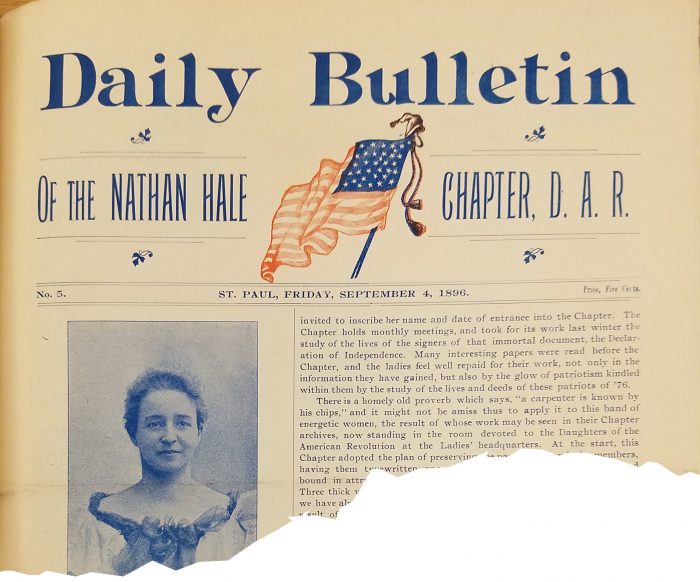
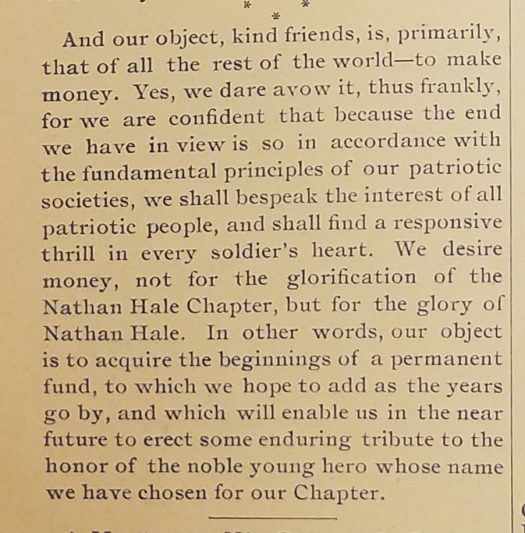
When they had gathered together several hundred dollars, the Chapter invested in an eight percent mortgage to earn money while they continued to save. For ten years they continued to make money by several means: they held card parties, dinners and musicales and solicited monetary donations.
In March 1906, the Nathan Hale Memorial Committee formally selected Frederick MacMonnies as their artist. Three Saint Paul locations were considered: Como Park, the newly-completed Minnesota Capitol grounds and the convergence of Summit, Portland and Western Avenues. The Chapter voted on November 6, 1906 to give the commission to Mr. MacMonnies for an 8-foot bronze statue of Nathan Hale similar to the statue commissioned by the Sons of the American Revolution and erected in New York City in 1893.
The Recording Secretary noted at the January 3, 1907, Nathan Hale Executive Board meeting that letters were read from two sculptors: William Partridge and Frederick MacMonnies. A motion was made, seconded and carried that the “order for MacMonnies’ statue be delayed until further arrangements could be made.”
We know that our Nathan Hale statue was created by William Ordway Partridge and unveiled on July 10, 1907. How was the Nathan Hale Chapter able to discontinue talks with one artist and obtain a completed statue by a different artist within a matter of months?
In her April 30, 1907, Chapter Historian Report, Belle Knuppe clarifies the Chapter’s quest for a Nathan Hale statue:
“For a number of years past, it has been the hope and plan of the chapter to erect to the memory of Nathan Hale, a replica of the statue in City Hall Park, NY made by Mr. Frederick MacMonnies, & about a year ago, it seemed as though our dream was about to be realized, when suddenly, like a thunderbolt out of a clear sky, comes the crushing news that the original model was broken and we “must abandon the project.” To repair the model, we felt was beyond our means, but “it is always darkest before the dawn” and good fortune was about to smile upon us in the form of Mr. Wm. Ordway Partridge, the sculptor. Many of us who had seen a picture of his statue of Nathan Hale made for the Yale Alumni preferred it to the MacMonnies or any other Hale statue. In short, we wrote Mr. Partridge with the result that he consented to accept what we were able to raise, model for us an original statue and being a patriotic “Son”, he offered to present to our society the creative part of the work. The final outcome of all this, you know, is to be the unveiling on June 6th of a beautiful statue of Nathan Hale, at the junction of Summit, Portland & Western Aves. the work of Mr. Partridge and the gift of Nathan Hale Chapter and patriotic citizens to the city of St. Paul.” [emphasis in the original]
Apparently, in the late 1890’s a committee of Yale University alumni considered purchasing this statue by William Ordway Partridge as a gift to their alma mater. However, within the alumni group there arose great differences of opinion and ultimately the Yale alumni decided not to commission the Partridge statue. [“Rejected at his Alma Mater, Hale lands in St. Paul” Manuscripts and Archives, Yale University Library, 2009]
When the Nathan Hale Memorial Committee found out about the availability of Partridge’s statue, they worked quickly. At the January 28, 1907, Nathan Hale Executive Board Meeting “there was a general discussion of the statue and several minor matters. It was moved by Mrs. White and seconded by Mrs. Knuppe that if the proportions of Mr. Partridge’s statue of Nathan Hale are satisfactory we send our first payment. The motion was carried.” The contract for the statue (“an original work and in no wise a copy or replica of any other work in existence”) was executed on March 1, 1907. In the contract between the artist and the Chapter, the cost of the statue and the payment schedule is carefully detailed with this caveat in Article Six: “The cost of this statue, as agreed upon between the parties of the first and second part, is to remain a secret…”
The Nathan Hale Executive Board met on March 14, 1907 and selected Mount Airy granite for the pedestal. In the contract, the Nathan Hale Chapter desired that the statue be shipped to Saint Paul in time for a June 6th dedication. However, “owing to the great delay in moving freight by the railroads it was decided not to fix the date of the unveiling until the statue and pedestal arrived in St. Paul.” [Nathan Hale Executive Board Meeting minutes, May 21, 1907]
At 10:15 am on June 27, 1907, members of Nathan Hale Chapter gathered informally at the site where the statue would be placed. Carolyn White, Chair of the Memorial Fund lead the group in prayer.
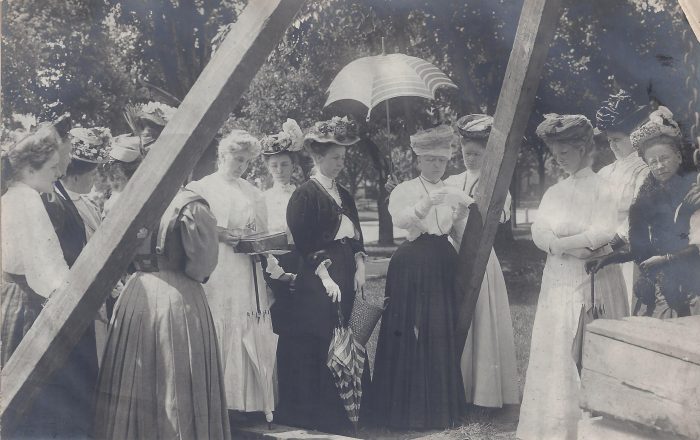
Chapter Vice Regent, Cora Brill, had donated a copper box which was filled with historical mementos and was placed inside the foundation.
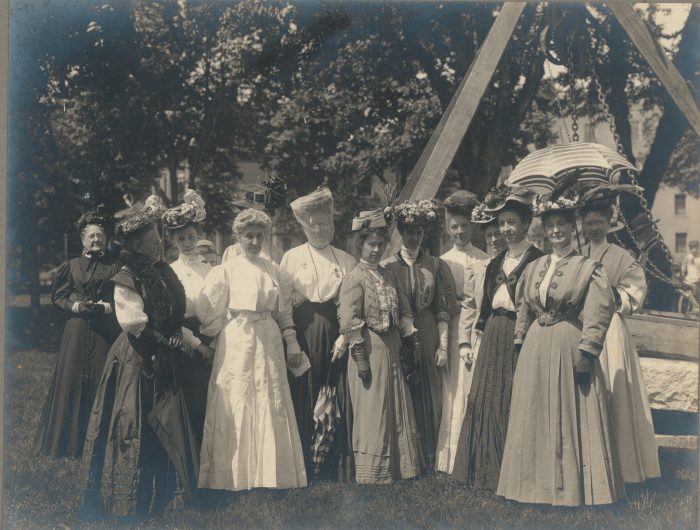
The ladies posed for a photograph at the conclusion of their short program. From left to right: Mother Elliott, Carolyn White, Kate Elliott, Mary Fagley, Grace Lyman (her hat is visible directly behind Mary Fagley), Julia Stevens, Harriett Gray, Louise Griggs, Jennie Ray, Edith Brill, Regent Alice Hall, Vice Regent Cora Brill, Alice Ray. (Photos from Nathan Hale Chapter Archives.)
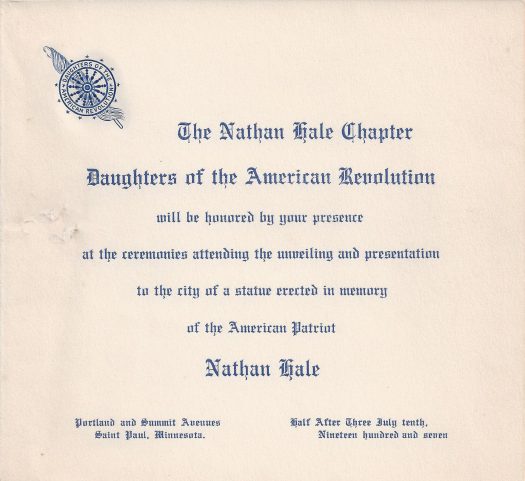
July 10, 1907: Nathan Hale Chapter planned a patriotic afternoon to present their gift to the City of Saint Paul. Prior to the unveiling there was music by the Minnesota State Band, an address from Minnesota State DAR Regent Frances Loyhed and a congratulatory message from U.S. Senator Moses Clapp. As she began to reveal the statue, Nathan Hale Chapter Regent Alice Hall pronounced:
“The moment is at hand when we are to give to you, the people of Saint Paul, the beloved object of our labor. It is not unmixed with joy but if we have helped to establish the principle displayed by our hero, our work has not been in vain. We ask you in return for our gift to foster in our schools and all the avenues of public life the same spirit that brought forth the wonderful sentiment from Nathan Hale, the American patriot.”
Saint Paul Mayor Robert Smith accepted the gift on behalf of the city. The Minnesota Band and the George Quartet led the assembly in singing “The Star Spangled Banner.” During the chorus, a great American Flag was unfurled above the statue. The Saint Paul Dispatch writer recorded that “the folds ‘broke out’ and the banner waved back and forth without pole or cord – a poetic apparition no less inspiring than unexpected. The mysterious flag was moved, in fact, by invisible wires stretched between tall trees.”
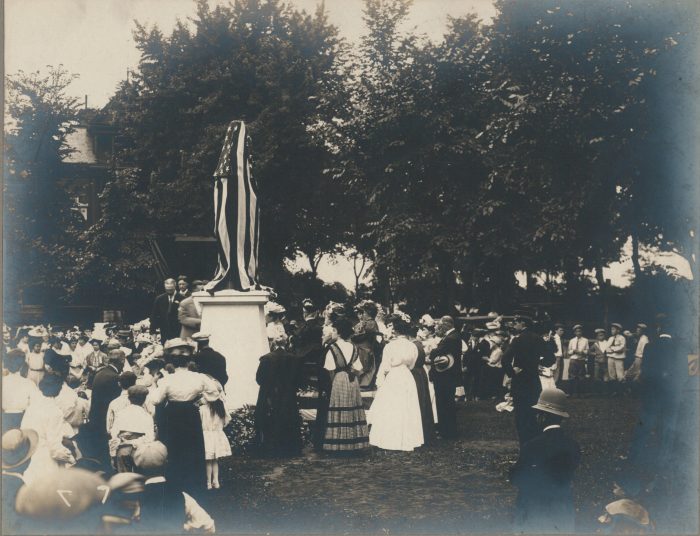
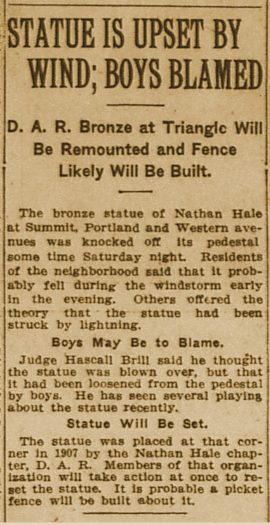
Through the years, the statue of Nathan Hale has evoked patriotic pride. Unfortunately, the statue has also endured Saint Paul’s weather. On the evening of Saturday June 20, 1914, a gusty spring storm blew through the city. In the morning, residents found the statue completely dislodged from the granite pedestal. Pitched down at an angle, Hale’s head was buried face-first in the sod while his feet were resting against the side of the granite base. The bronze rope that bound his hands was severed. Some neighbors speculated that the statue was hit by lightning; some said the strong wind blew the monument off its base.
Minnesota District Court Judge Hascal Brill was quoted in the June 22, 1914, Pioneer Press that “he thought the statue was blown over, but that it had been loosened from the pedestal by boys. He has seen several playing about the statue recently.” [Note: Judge Brill’s wife was Nathan Hale Chapter Vice Regent Cora Brill. They lived 4 blocks from Nathan Hale Park.]
By 1962, the statue was showing signs of its age. The Saint Paul Pioneer Press (September 23, 1962) described the “soft blue-green patina” that enhanced the statue. Public Art Saint Paul chronicles the statues acrobatics in the 1970s: A boom truck working on elm removal struck the sculpture’s pedestal with such force that it ripped the sculpture and its 800 pound base from the pedestal and sent them flying through the air. When it landed, the sculpture’s feet were twisted and mangled. The statue was hauled off to a storage lot where it was left on the ground in the snow and mud for almost a year. When an attempt was made to restore it and put it back in place, a monument company was called in. They sand-blasted the bronze as though it were stone, pitting it horribly. Not being able to figure out how to reattach the figure’s feet to a base, they sawed off the heels and bolted the statue to the base with lead pins — inviting galvanic corrosion. These pins had completely disintegrated by the early 1990s, leaving the sculpture with no attachment whatsoever.
In October of 1993, the Nathan Hale statue was taken to Anurag Sculpture Studio where the Upper Midwest Conservation Association was tasked with the restoration work. According to a Minneapolis Star Tribune article (June 28, 1995) the statue’s seams were split, its once black skin was pockmarked and stained green, rust streaked its ankles, a bronze button was missing, car repair putty streaked the coat and the bronze ropes were still broken (from the 1914 incident). Kristin Cheronis, the supervisory sculpture conservator said that the Nathan Hale statue had endured “what we would politely call a heavy-handed repair job.”
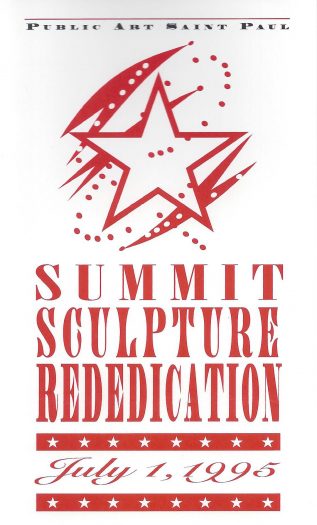
(All photos, clippings, memorabilia and letters are from Nathan Hale Chapter Archives.)
Nathan Hale Statue written by Karrie Blees, 2018.

